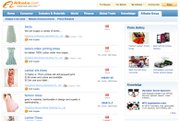Online Sourcing Bridges the Gap for Buyers, Sellers
Finding offshore manufacturing partners is becoming a little easier for some apparel companies thanks to a growing list of online sourcing databases and matchmaking services.
Online sourcing resources bring the world’s factories close at hand with extensive databases as well as matchmaking services. Software programs are also helping to manage the many steps involved in securing materials and goods. As a result, there’s less need to make overseas trips to visit factories and trade shows.
Companies such as Alibaba (www.alibaba.com), based in Hangzhou, China, and with U.S. offices based in Santa Clara, Calif., started it all nine years ago when it launched as a trading platform for China’s smaller manufacturers. It has since grown to accommodate more than 30 million registered users from more than 200 countries. Visitors can find factories for virtually every product on the planet, including apparel and textiles, which are among the largest categories.
The large registration base comes from being a free site for buyers and sellers. Alibaba makes most of its revenues off of its key gold-level members, who pay fees for more visibility as well as accessibility. Alibaba executives said gold-level members receive 12 times more inquiries than free members.
Buyers can either search the database or post ads stating exactly what they are looking for. The site offers anonymity to protect stores from a groundswell of phone calls.
Alibaba’s growth has landed the company on the Hong Kong stock exchange. When it went public late last year, it was the biggest IPO since Google. Yahoo! invested $1 billion in the company.
Its success has also spawned a growing base of competitors such as New York–based e-Source Apparel and Fremont, Calif.–based All World Sourcing Inc.
The newer entries have chosen to specialize in apparel rather than blanket all consumer and industrial products like Alibaba does.
eSourceApparel (www.esourceapparel.com) launched last year as a sourcing database as well as a vehicle for inventory sales. It started in 2007 with about 30,000 contacts and has since grown to about 65,000. The site is free. The company makes most of its revenues off of advertising on the site.
eSource provides contacts for all aspects of the supply chain, from conceptual services—including yarn dyeing, trend forecasting, pattern-making, marking and grading—to manufacturing, warehousing, freight forwarding and agents.
The company will be adding a financial component to the site next month, said Principal John Barsoli. As a result, buyers will be able to complete transactions with sources acquired from the site.
“This will allow members to secure financing. We’ve partnered with a few financial firms to help with this,” he said.
Barsoli said the site’s inventory sales have grown to more than 4 million units along with 2 million yards of textiles. “We’re seeing a minimum of 150 members per week joining eSource,” Barsoli said.
Silicon Valley newcomer All World Sourcing (www.allworldsourcing.com) characterizes itself as the eBay of sourcing. The site works similarly to financial lending sites such as LendingTree (www.lendingtree.com); buyers submit requests for products and receive a host of bids from AWS’ list of about 10,000 suppliers.
“We actually go out and find the best sources for the buyers,” said company Chief Executive Officer Tony Oyang. “But rather than take our word for it, the site offers a complete due-diligence process that works in favor of the buyers.”
Part of that process enables buyers to view feedback from other customers about manufacturers.
AWS currently has a promotion offering buyers a 3 percent rebate for their first completed transaction. The site is free for buyers. Suppliers pay a commission fee.
“Other sites operate more like a Craigslist,” explained Oyang. “You put an ad out saying that you sell widgets. You pray you get the right seller. We’re more like a 1-800 Dentist. We go out and find the right supplier, and the beauty of the system is that you don’t have to use our sources. You can add others that you have worked with to get a shot at your business.”
Oyang said that while virtual sourcing lacks the immediate face-to-face encounters, it does have other advantages.
“I recently returned from a trade show in Hong Kong where there were hundreds of suppliers. Everyone said they were the best. I invested about $2,000 in a hotel and travel and didn’t feel confident coming away from it. You don’t have to invest that when you’re working online,” he said.






















